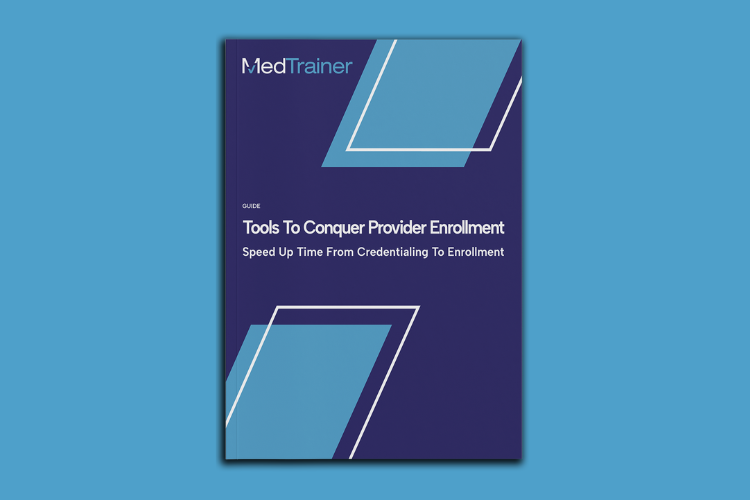With nearly 67 million members, Medicare is the largest healthcare insurance entity in the U.S. – dwarfing Kaiser Permanente, the biggest private payer serving 8.2 million enrollees. But Medicare provider enrollment – like signing up with any private payer – isn’t a walk in the park.
Medicare provider enrollment is a three-step process that requires specific forms and strict document naming conventions that can trip up even the most diligent credentialer. This blog will outline the Medicare provider enrollment process and discuss how technology speeds up application approval.
Who Can Enroll Providers With Medicare?
There are three categories under which a healthcare organization can submit Medicare provider enrollment applications with the Centers for Medicare and Medicaid Services (CMS):
- Institutional Providers: Hospitals, critical care facilities, skilled nursing facilities, home health agencies, rural health clinics, Federally Qualified Health Centers (FQHC), and hospice programs that provide services to Medicare beneficiaries.
- Part B Suppliers: Laboratories, clinics, physical therapists, clinical social workers, and non-physician practitioners.
- Provider and Supplier Organizations: Business structures, like corporations, partnerships, professional associations, or limited liability companies, which meet the provider and supplier definitions. Provider and supplier organizations don’t include organizations the IRS defines as sole proprietorships.
How do you know what category is right? The Medicare application portal lists questions to guide you to the choice that best fits your needs. It is critical to answer the questions correctly. You must redo the entire process if you submit the wrong form. Ask these questions when completing the application:
- Application Type: Are you submitting an institutional clinic or group individual application?
- Ordering Referring Prescribing: Does your facility need to be directly credentialed, or are you applying for new medical residents at the start of their careers?
- Tax Designation and IRS Setup: Are you a sole proprietor or an LLC disregarded entity?
Completing Your Medicare Provider Enrollment
There are three steps to submit a successful Medicare provider enrollment application, though most credentialers know there are more than that:
Step 1: Get an NPI
The National Provider Identifier Standard (NPI) is a unique identification number for covered healthcare providers. NPIs are issued through the National Plan & Provider Enumeration System (NPPES). Not sure if you have an NPI? Search the NPI Registry. If you already have an NPI, skip this step and proceed to Step 2.
Step 2: Complete the Medicare Enrollment Application
Enroll using the Provider, Enrollment, Chain, and Ownership System (PECOS), the online Medicare enrollment system. PECOS has video and print tutorials and will walk you through your enrollment to ensure accurate information.
Step 3: Work With Your MAC
A Medicare Administrative Contractor (MAC) is a private healthcare insurer that has been awarded a geographic jurisdiction to process Medicare Part A and Part B (A/B) medical claims or Durable Medical Equipment (DME) claims for Medicare Fee-For-Service (FFS) beneficiaries. Your MAC is specific to the region where you practice and may have additional requests for information while they process your application. You can also check in with your MAC regarding your enrollment status.
This may seem simple, but the information needed to complete a Medicare enrollment application – or one for any payer – is much more complex. Here’s a checklist of what’s required for one provider enrollment:
Gather Training and Education
- Practitioner degree (MD, DO, DPM), post-graduate education or training
- Details of medical or professional education and training
- Completion of a residency program in the designated specialty
Gather Licensing and Certification
- Current license or certification in the state(s) in which the care provider will be practicing (no temporary licenses)
- National Provider Identification (NPI) number
- Specialty (surgeons need board certification, RNs don’t need anything else)
- Active Drug Enforcement Agency (DEA) number and/or Controlled Dangerous Substance (CDS)
- Certificate or acceptable substitute (if required)
- Medicare/Medicaid participation eligibility or certification (if applicable)
Gather Work History Details
- Five-year work history. If there are any gaps longer than six months, please explain
- Statement of work limitations, license history, and sanctions (only required if you are applying to join UnitedHealthcare’s Medicare and Medicaid plans)
- W-9 form
- Hospital staff privileges
Gather Payer-Specific Requirements
- Active errors and omissions (malpractice) insurance or a state-approved alternative
- Malpractice history
- Special needs survey
- LOI
- Disclosure of ownership statement
- Other credentialing requirements such as AMA profile or criminal history review as required by credentialing authorities
- Notification if this provider has ever been a delegated provider before this credentialing application
- Complete the credentialing application in the portal
Following Application Submission
- Check the application at one week
- Check the application at two weeks
- Obtain credentialing approval via the portal
Once the application is submitted to Medicare, you play the waiting game to see if CMS approves, denies, or rejects enrollment. A denial or rejection means you start over. Getting it right the first time is essential – and that’s where credentialing software is invaluable.
Credentialing Software Simplifies Medicare Provider Enrollment
Any credentialer will say Medicare’s three steps are only a part of what goes into a successful enrollment. Enrolling a single provider with Medicare typically takes 4-8 hours of uninterrupted time. Credentialers must collect an average of 30 documents per provider, which boosts the total time to an average of 10 hours.
Medicare provider enrollment can be a long, complex process. Credentialing alone requires hours to prepare one provider application. Credentialing and enrollment software can help manage the process from start to finish. Digital solutions offer automated features to expedite document collection and reduce delays that can cost your organization significant revenue.
MedTrainer Credentialing all-in-one software offers comprehensive provider profiles, automated license verification and exclusions monitoring, and a proven enrollment workflow. If you want to outsource your credentialing, consider MedTrainer Credentialing Service, where regionally based credentialing specialists handle every aspect of your credentialing process, from primary source verification to enrollment.
To help you manage applications independently, we’ve created Enrollment Checklists to ensure you gather the necessary information before starting a Medicare provider enrollment application. The easy-to-follow steps are part of our Tools to Conquer Provider Enrollment guide.

Get the tools you need to eliminate delays in your provider enrollment process.
Ready to tackle Medicare provider enrollment. Contact us to get started.
